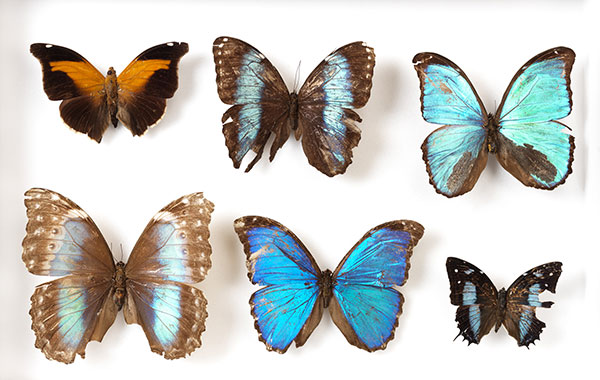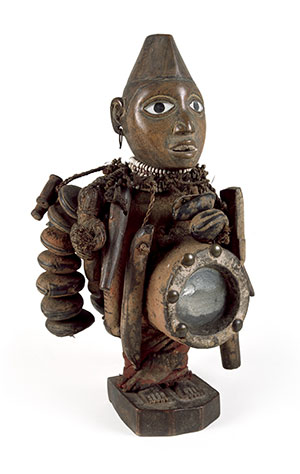Roger Casement—voice of the voiceless
Published in Issue 1 (January/February 2017), News, Volume 25EXHIBITION AT THE NATIONAL MUSEUM OF IRELAND, KILDARE STREET
By Fiona Reilly

Above: Butterflies of the Nymphalidae family collected by Roger Casement in modern southern Colombia. (National Museum of Ireland)
Radiant butterflies collected by Roger Casement in present-day Colombia greet visitors on entering a new exhibition at the National Museum of Ireland, Kildare Street. Through the use of diverse and skilfully made objects collected and donated by Casement, museum letters and registers and contemporary photographs, the exhibition explores Casement’s humanitarian work in investigating atrocities in the rubber trade in Africa and South America. It offers a rare chance to see on public display objects from the museum’s ethnographic collections.
Roger Casement worked in various employments in Africa before starting his diplomatic career in 1895. In 1900 he was appointed British consul to the Congo Free State (now the Democratic Republic of Congo), and consul-general to Brazil in 1906. He was chosen to investigate allegations of misconduct in the rubber trade in the Congo Free State and the Putumayo area of Peru (now in Colombia). His Congo and Putumayo reports drew global attention to the atrocities and earned him a knighthood in 1911.
The cause of the atrocities was uncontrolled greed for rubber or ‘black gold’. Rubber is produced from a latex sap extracted from rubber trees or vines and was used in electrical wiring, for waterproofing and in tyres. Before the establishment of rubber plantations it was collected from the wild. Processed rubber was transported in baskets, one of which is on display, as are fibre handcuffs noted by Casement as having been used by forest sentries in the Congo. The production process involved the brutal exploitation of native peoples and resulted in the genocide of entire communities. The legacy of this period is still felt in these regions today.
During the late nineteenth century European colonial powers vied for control of the Congo region. In 1885 the claim of a private company controlled and owned by King Leopold II of Belgium was recognised. In 1903 criticism of the methods used in Leopold’s repressive rubber regime resulted in Casement being instructed to investigate. In June of that year Casement travelled up the River Congo, and in comparison with a previous trip in 1887 he found a diminished and brutalised population. His report was published in 1904, in the same year that Edmond Morel founded the Congo Reform Association. This association increased public awareness of the atrocities and agitated for reform. Eventually, in 1908, the Congo Free State was annexed to the Belgian state and the welfare of the indigenous population improved.

Above: Nkisi figure made by the Vili people of Cabinda, Angola. (National Museum of Ireland)
Nkisi figures were used by the nganga (ritual specialists) to focus spiritual power. The pointed hairstyle of the figure on display suggests that it was made by the Vili people who lived along the Atlantic coast north of the mouth of the Congo River. Other African objects on display include a wicker shield and an impressive knife with a wooden sheath made by the Mongo people of the Congo river basin.
In the 1850s rubber companies started to extract wild rubber from the Amazon rain forest. One company, called the Peruvian Amazon Company, was registered in London but was owned by a Peruvian, Julio César Arana. Casement, who started his investigation in 1910, found a system of indentured and sexual slavery and horrendous treatment of the indigenous population. Through murder, mutilation and deliberate starvation, around 40,000 indigenous people had been exterminated in the Putumayo region alone. His findings were published in 1912 and caused global outrage.
On display are three pottery equestrian figures that depict the maker’s idea of European settlers in northern Brazil, and a bark-cloth dance costume hood from the Putumayo River area of Colombia. Casement describes in his journal attending community dances and also photographed them.
The exhibition ends with the present day because, sadly, the issues that Casement encountered over 100 years ago—land rights, slavery, child labour, genocide, the ill-treatment of indigenous people and the prioritisation of business over human rights—are still relevant. Casement stated in an essay that ‘the rubber was there. How it was produced, out of what a hell of human suffering no one knew, no one asked, no one suspected. Can it be no one cared?’ Today we can easily replace the word ‘rubber’ with a modern-day commodity. It is hoped that the exhibition will not only raise awareness of Casement’s humanitarian work and the people who were exploited but will also stimulate us to think more deeply about the supply chain of goods we buy today, to question disrespectful treatment of workers and to ask ourselves ‘Do we care?’
Fiona Reilly is Assistant Keeper of Irish Antiquities at the National Museum of Ireland.
















